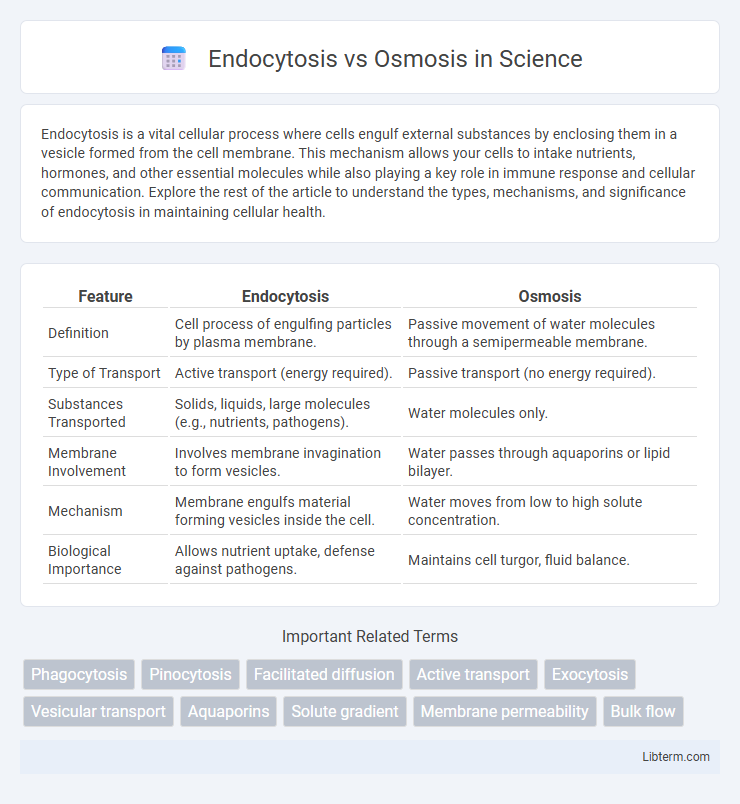Endocytosis is a vital cellular process where cells engulf external substances by enclosing them in a vesicle formed from the cell membrane. This mechanism allows your cells to intake nutrients, hormones, and other essential molecules while also playing a key role in immune response and cellular communication. Explore the rest of the article to understand the types, mechanisms, and significance of endocytosis in maintaining cellular health.
Table of Comparison
| Feature | Endocytosis | Osmosis |
|---|---|---|
| Definition | Cell process of engulfing particles by plasma membrane. | Passive movement of water molecules through a semipermeable membrane. |
| Type of Transport | Active transport (energy required). | Passive transport (no energy required). |
| Substances Transported | Solids, liquids, large molecules (e.g., nutrients, pathogens). | Water molecules only. |
| Membrane Involvement | Involves membrane invagination to form vesicles. | Water passes through aquaporins or lipid bilayer. |
| Mechanism | Membrane engulfs material forming vesicles inside the cell. | Water moves from low to high solute concentration. |
| Biological Importance | Allows nutrient uptake, defense against pathogens. | Maintains cell turgor, fluid balance. |
Introduction to Endocytosis and Osmosis
Endocytosis is a cellular process in which the cell membrane engulfs external substances, forming vesicles to bring materials into the cell. Osmosis is the passive movement of water molecules across a semipermeable membrane from an area of low solute concentration to high solute concentration. Both processes are essential for maintaining cellular homeostasis and regulating the internal environment of cells.
Defining Endocytosis: Cellular Uptake Process
Endocytosis is a cellular uptake process where cells engulf external materials by invaginating the plasma membrane to form vesicles, enabling the internalization of large particles, fluids, and macromolecules. Unlike osmosis, which involves the passive movement of water across a semipermeable membrane driven by concentration gradients, endocytosis is an active, energy-dependent mechanism essential for nutrient intake, immune responses, and cellular signaling. Key types of endocytosis include phagocytosis, pinocytosis, and receptor-mediated endocytosis, each specializing in different substrates and functions within cellular physiology.
The Mechanisms of Osmosis Explained
Osmosis is the passive movement of water molecules across a selectively permeable membrane from an area of low solute concentration to high solute concentration, aiming to equalize solute levels on both sides. This process relies on the concentration gradient and does not require cellular energy, distinguishing it from endocytosis, which is an active transport mechanism involving the engulfing of particles. Osmosis plays a critical role in maintaining cell turgor pressure and fluid balance in biological systems.
Key Differences Between Endocytosis and Osmosis
Endocytosis is a cellular process involving the active engulfment of particles or fluids into vesicles, requiring energy input, while osmosis is the passive movement of water molecules across a semi-permeable membrane from a region of low solute concentration to high solute concentration. Endocytosis transports large molecules or particles such as nutrients and pathogens into the cell, whereas osmosis regulates water balance to maintain cellular homeostasis. Unlike osmosis, which occurs due to concentration gradients, endocytosis depends on cellular machinery like cytoskeleton and membrane receptors.
Types of Endocytosis: Phagocytosis and Pinocytosis
Phagocytosis and pinocytosis are two primary types of endocytosis, a cellular process distinct from osmosis, which involves the passive movement of water across a semipermeable membrane. Phagocytosis, often called "cell eating," enables cells to engulf large particles or pathogens, playing a crucial role in immune response. Pinocytosis, referred to as "cell drinking," allows cells to ingest extracellular fluid and dissolved substances, facilitating nutrient uptake and cellular maintenance.
The Role of the Cell Membrane in Endocytosis and Osmosis
The cell membrane plays a crucial role in both endocytosis and osmosis by regulating the movement of substances into and out of the cell. In endocytosis, the membrane actively engulfs large molecules or particles by forming vesicles, enabling the internalization of nutrients, signaling molecules, and pathogens. During osmosis, the selectively permeable membrane facilitates the passive diffusion of water across the membrane, maintaining cellular homeostasis by balancing solute concentrations inside and outside the cell.
Biological Significance of Endocytosis in Cells
Endocytosis plays a crucial biological role by enabling cells to internalize large molecules, nutrients, and signaling molecules that cannot pass through the plasma membrane via passive diffusion or osmosis. This active process supports nutrient uptake, receptor-mediated signaling, and removal of pathogens, which are vital for cellular homeostasis and immune responses. Unlike osmosis, which involves passive water movement to balance solute concentration, endocytosis directly manipulates the cellular membrane to engulf extracellular materials, facilitating complex cellular functions and adaptation.
Importance of Osmosis in Maintaining Cellular Homeostasis
Osmosis is critical for maintaining cellular homeostasis by regulating the movement of water across cell membranes, ensuring cells maintain their proper shape and volume. This passive transport process enables cells to balance internal and external solute concentrations, preventing dehydration or swelling that can disrupt metabolic functions. Unlike endocytosis, which actively transports large molecules and particles, osmosis preserves the cell's equilibrium through the selective permeability of the lipid bilayer and aquaporin channels.
Real-Life Examples of Endocytosis and Osmosis
Endocytosis occurs in immune cells like macrophages engulfing bacteria to protect the body, while osmosis is critical in plant cells absorbing water through roots to maintain turgor pressure. White blood cells utilize endocytosis to internalize pathogens for destruction, whereas kidney cells rely on osmosis to regulate water balance and filtration in the body. These processes highlight cellular mechanisms for nutrient intake and fluid regulation vital to life functions.
Summary: Comparing Endocytosis and Osmosis in Cell Biology
Endocytosis is an active transport process where the cell membrane engulfs materials to bring them inside, requiring energy, while osmosis is a passive movement of water molecules through a semipermeable membrane from low to high solute concentration. Both are essential for maintaining cellular homeostasis but serve different functions: endocytosis transports large particles or solutes, whereas osmosis regulates water balance. Understanding these mechanisms highlights their roles in nutrient uptake and volume regulation within cells.
Endocytosis Infographic

 libterm.com
libterm.com